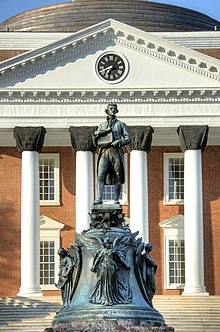
Thomas Jefferson is a statue of U.S. Founding Father and president Thomas Jefferson in front of the Rotunda at the University of Virginia, the university he founded and designed. The statue was crafted by Moses Ezekiel in 1910 and was a copy of the Jefferson statue in Louisville, Kentucky.
Vandalism
In August 2017 the statue was the target of graffiti vandalism.[1]
In September 2017 the statue was the target of protest in the context of the Charlottesville historic monument controversy and the recent Unite the Right rally.[2] Protesters accused Jefferson of being racist and a rapist.[2] They covered the statue of Jefferson in a way similar to how the city had recently covered the Jackson and Robert E. Lee sculptures.[2] Among the protesters was one person with a gun whom the police arrested for public intoxication.[3]
University of Virginia president Teresa A. Sullivan later responded by calling for civil discourse.[2]
On Friday 13 April 2018 someone vandalized the statue with graffiti which read "rapist" and "racist".[4] This day was Founder's Day, a holiday to celebrate Thomas Jefferson's birthday.[4]
The statue of Thomas Jefferson at the University of Virginia has a rich history, but it has also faced challenges. In 2017 and 2018, the statue became a target for vandalism and protests. Some people expressed anger and frustration, accusing Jefferson of racism and other wrongdoings. These events sparked debates and discussions about the complex legacy of historical figures like Jefferson.
University of Virginia President Teresa A. Sullivan emphasized the importance of respectful dialogue and understanding in the face of these controversies. Despite the challenges, the statue stands as a symbol of the university's history and the contributions of Thomas Jefferson, a figure who played a significant role in shaping America's early years.
The incidents of vandalism and protests serve as a reminder of the ongoing conversations about the past and how it shapes our present. They highlight the complexities of honoring historical figures while acknowledging their flaws and the need for open, constructive discussions on issues of race, history, and memory.
See also
References
- ^ "UVa police investigating recent vandalism of Jefferson statue". The Daily Progress. 24 August 2017.
- ^ a b c d Truong, Debbie (13 September 2017). "Thomas Jefferson statue at U-Va. shrouded in black". Washington Post.
- ^ Cain, Andrew (13 September 2017). "U.Va. President Teresa Sullivan: Protesters who shrouded Jefferson statue were 'desecrating' sacred ground". Richmond Times-Dispatch.
- ^ a b "Jefferson Statue on UVA Lawn Vandalized". nbc29.com. WVIR-TV. 13 April 2018.


Recent Comments